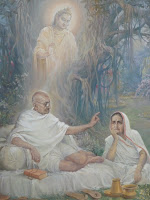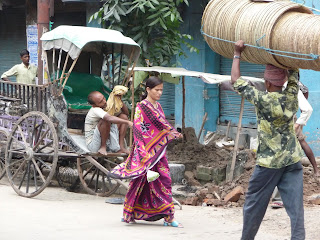
Pune, India, July 25, 2008, (kids in chorus). We visited the Centre for Learning Resources, an organization that works on early childhood care and development and elementary education. They create low cost kits in mathematics for rural schools as one of the many things they do. The most interesting thing I learned is they created a 15 minute radio program to teach rural India students English. For three years they collected data and showed what the effects of a 15 minute in class interactive radio show could do for rural schools. They repeat the shows in the evenings so that parents can listen with their children. There results are incredible. There program is kind of like PBS programs in America. The controversy is the government wants kids to learn Hindi, the national language. The problem is there are over 25 recognized launguages in India and every kid learns there mother tongue, then Hindi and then English, which is three launguages. In India the language to success is English, as that is the language of higher education. The centers argument for learning English is that it opens the doors to education for every child in India, not just the upper castes. The politicians in this state do not follow the national curriculum and create their own. If a group develops some really good curriculum, the state won’t use it, as they want sole intellectual rights to what ever is published. This group created a $40 dollar math kit that was awesome, but it was to expensive so they had to cut it down to a $10 kit. When you are talking curriculum in India and the sheer volume of schools and classrooms, it is easy to see why the schools don’t have much money.
We visited Janna Prabhodhini, a 5th-10th grade school for gifted students. It was a very interesting five story building with a large open court yard in the middle. From the outside, it didn’t look like much because it is in the city near many street vendors and shops. The school gets 1000 applications for 80 slots. Once kids get into this school, few drop out. This is the first school that looks at gifted education the same way we look at gifted education in America. They look at the musically, athletic, artistic and intellectually talented students and provide them with counseling. Most governmental schools focus on math, science, Hindi, English, and government. They try to make well rounded students and make students go out to rural villages and work in rural schools as part of their volunteer work. The school wants students to give back to their county in some way. All students are going to college at this school. Some will go to an art, music or business school. A few will get in to the IIT’s (subsidized college for the elite). Since this school only goes through 10 standard ( a big stepping stone as across India many drop out at this point), all go to other schools or community type college to finish there education. Many students from this school go on to become doctors and set up free rural clinics. A very interesting school as they have students working with rural farmers trying to get them to use worms for composting, help educate farmers about animal vaccinations and teaching them how to grow cut flowers as a cash crop. Many students at this school are on grants as they try to bring in students from all castes and social-economic status.
On the way back from the school, the bus dropped us off at a large, new movie theater. You can not talk about India without mentioning Bollywood, in Mubia. More movies are created here than in America. A Bollywood movie has a certain script that it follows which always includes dancing and singing. They are rather lengthy with a five minute intermission. We went and saw Jaane Tu Ya Jaane Na, a high school/college chick flick. It was really funny as two of the USEFI organizers came with us. We had one in each row so they could interpret for us as there were no subtitles. Bollywood movies use English every few sentences and they curse in English. There definitely is some humor that the American’s laughed at but not the natives. The funny part was the USEFI woman told the person on there right what was going on, and then they would tell the next person to there right and so forth. It took about five minutes to reach the last person. We would all be laughing at the wrong times. It was a pretty funny experience and we were able to follow the plot mostly. In the movie theater you forget that you’re in a third world country. Movies are very popular in India with only the middle and upper class able to afford a movie. When a movie comes out you usually have to buy tickets in advance and your seat is assigned. When you step out on the street you are hit with the smell of urine, you see the construction workers digging with a large crude shovels scooping dirt into pans that woman put on there heads and haul off to truck. While waiting for the bus, a young girl of about seven, with a baby on her hip, less than a month old, grabs my hand and begs for money. It is a sad state of affairs. In this country, if you are born into poverty, there is no escape, which is your lot in life. Education is the only way out and not every one here has an equal chance at an education. The poor children stay home to help the family. You see kids in small shops or as side walk vendors helping their parents. I am beginning to realize how important it is in America to educate every kid in America. Education is the equalizer. In India education is so highly valued, that much pressure is put on students that can afford to go to school, to succeed. I wish in America education was as valued as it is in India; we would be a much more successful country.






























